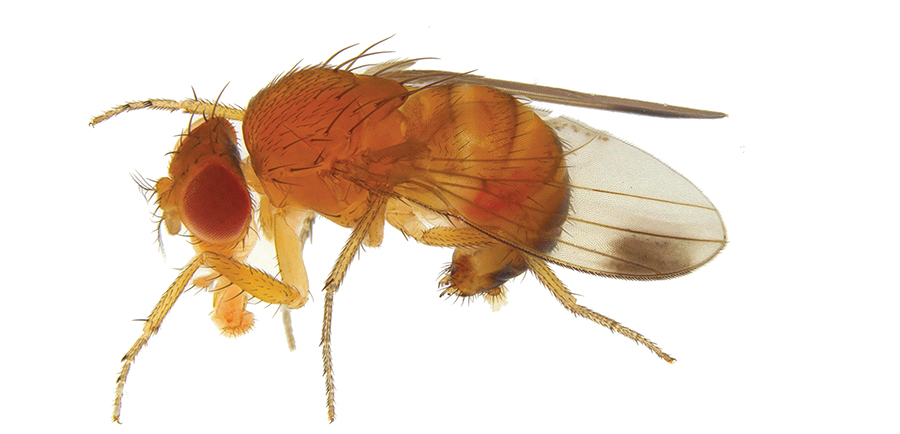Battling an invasive alien insect: SWD Research
by: Miranda Elsby
The Spotted Wing Drosophila (SWD), scientific name Drosophila suzukii, is the newest fly pest to British Columbia fruit growers.
This aggressive fly is native to South East Asia, with reports of observation in the Hawaiian Islands in the 1980’s. The pest then made its jump to mainland North America in 2008, being seen in California and making its way north to British Columbia. It is now well established in both lower mainland BC and the Okanagan, being spread mainly by the transport of infested fruit. The berry and stone fruit growers in the area are now fighting an invasive imported pest, introduced to their crops by the very fruit they compete with in the marketplace.This challenging pest is closely related to the household fruit fly (Drosophila melanogaster). Its 2.0-3.5mm body is usually tan to dark brown in colour, with darker bands running across the abdomen. Both males and females have bright red eyes, a key ID feature when scouting for this pest. The males have the characteristic black spots near their wingtips, coining the name “Spotted Wing Drosophila”. Females have no spots on their wings, and are most readily identified by their large serrated ovipositor, which also happens to be their greatest weapon against BC’s fruit crops.
The laying of eggs within ripening fruit is what causes the greatest economic loss for growers. Flies overwinter as adults in the field, and upon emergence in the spring, the female fly is able to use its large, saw-like ovipositor to puncture the skin of ripening fruit, laying its eggs inside. This is where SWD differs from its relative, the household fruit fly, which has a smaller ovipositor and is more attracted to rotting or soft fruit for egg deposition, versus a commercially valuable ripening crop. Once the eggs have hatched, larval stages begin feeding on the inside of the fruit, causing softening and collapse, greatly limiting the grower in fresh fruit market opportunities. These openings in the fruit are also an invitation for disease, including brown rot and botrytis, both especially important threats during times of high humidity and precipitation.
Current monitoring programs for this pest have shown the greatest success with simple apple cider vinegar traps. However, fruit processors are finding larval stages in the crops even before adults show presence in traps, so this information is limited and unsatisfactory to growers. BC trapping has shown that adult fly activity is year round, with low points between February and May when the insect is in a non-productive state. While adult monitoring is not the most accurate, it is the easiest method when compared to visual inspection for infestation, as it is very difficult to inspect fruit for the tiny oviposition puncture marks. Collapsed or soft fruit can be indicative of feeding larvae, and can be tested for presence using sugar or salt extraction methods. The fruit can be lightly crushed, covered in a sugar or salt solution, and allowed to sit while any larvae present float to the top. However, this method is only helpful in confirming the presence of immature stages, and does not aid in damage prevention. Early seasonal detection of adult fly activity is imperative in minimizing yield loss, which will hopefully become easier and more reliable as research provides growers with management tools.
Research efforts in regards to the biology of this pest were undertaken immediately upon its discovery in the area. Current projects at Agriculture and Agri-Food Canada in Agassiz include seasonal tracking of the ovarian development of female flies, as well as investigation into possible natural predators. Ag Canada’s Summerland scientists also have ongoing projects addressing pathology, insecticide resistance, and population dynamics of this insect. To track ovarian development, wild female flies are collected from outdoor apple cider vinegar traps, as well as reared artificially, and then dissected in order to determine ovary size and diapause progression, a period during which physiological activity is diminished. By tracking the gradual shutdown of the reproductive organs, scientists hope to better understand reproductive timing and seasonal diapause in outdoor populations. Natural predators of this pest, or parasitoids, are also being investigated. There have been a few beneficial parasitoids of SWD found in BC, but further research hopes to discover more, specifically those targeting pupal stages of the fly. By identifying such parasitoids, growers would be armed with the knowledge of a natural enemy in the field, possibly aiding in the suppression of SWD in their crops.
As with most difficult agricultural pests, it is important to apply an encompassing management program, with both cultural and chemical controls being utilized. Suppression of this pest is best accomplished with a diligent monitoring program, ideally beginning very early in the growing season. As soon as SWD has been found in the area near a ripening crop, insecticide sprays should be initiated, being careful to alternate chemical groups to avoid an evolved insect resistance. Blackberries and other wild fruit crops around the perimeter of a field can serve as alternate hosts, and should be monitored carefully for SWD presence, or removed if possible. Any grass between rows should be kept mown, especially during harvest when dropped fruit can attract flies. To further remove other unwanted attractants of the flies, culled fruit should be buried at no less than 12 inches or solarized in plastic bags, ensuring the death of any developing SWD larvae in the collected fruit. Additionally, crops should be picked completely clean after harvest, coupled with a post-harvest spray application, leaving no opportunities for the flies to continue breeding in the field or overwinter. Emergency registered insecticides for this past season included Malathion 85E and 25W, Ripcord 400EC (cypermethrin), Delegate WG (spinetoram), Entrust 80W (spinosad), and Pyganic EC (pyrethrins).












